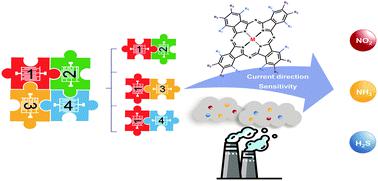当前位置:
X-MOL 学术
›
New J. Chem.
›
论文详情
Our official English website, www.x-mol.net, welcomes your feedback! (Note: you will need to create a separate account there.)
A phthalocyanine sensor array based on sensitivity and current changes for highly sensitive identification of three toxic gases at ppb levels
New Journal of Chemistry ( IF 3.3 ) Pub Date : 2020-06-30 , DOI: 10.1039/d0nj02025g Xueqian Duan 1, 2, 3, 4 , Yingze Zhang 1, 2, 3, 4 , Haoyuan Wang 1, 2, 3, 4 , Fangna Dai 1, 2, 3, 4 , Guangwu Yang 1, 2, 3, 4 , Yanli Chen 1, 2, 3, 4
New Journal of Chemistry ( IF 3.3 ) Pub Date : 2020-06-30 , DOI: 10.1039/d0nj02025g Xueqian Duan 1, 2, 3, 4 , Yingze Zhang 1, 2, 3, 4 , Haoyuan Wang 1, 2, 3, 4 , Fangna Dai 1, 2, 3, 4 , Guangwu Yang 1, 2, 3, 4 , Yanli Chen 1, 2, 3, 4
Affiliation

|
A series of cobalt and metal-free phthalocyanine ambipolar semiconductors, MPc[β/α-O(4-CF3-Ph)4] (M = Co, 2H) (1–4), are synthesized and fabricated into self-assembled microstructures. The Co[Pc(β/α-OPhCF3)4] (1 and 3) molecules formed one-dimensional (1D) nanoribbons (400–300 nm) with a larger width of 1 relative to 3, whereas the H2Pc[β/α-O(4-CF3-Ph)4] (2 and 4) molecules self-assembled into wider microbelts (5–4 μm) with 2 larger than 4, showing the effect of the M center and the substituent positions of the Pc rings on the dimensions of the microstructures. An increased crystallinity is revealed in the order of 4 < 3 < 2 < 1, resulting in an increased conductivity in the same order. Towards NO2 and NH3, both positive and negative current changes are found among the sensors 1–4, with the lowest limit of detection (LOD) as low as 3 ppb for NO2 and 420 ppb for NH3 from 1, while a positive current response to H2S is obtained only from 1 with a LOD of 100 ppb, respectively, achieving the best results for the room-temperature detection of NO2, NH3 and H2S gases based on all of the solution-processed phthalocyanine-based sensors reported so far. Accordingly, the sensor responses are dominated by both M-analyst interaction (M = Co, 2H) and conductivity among the sensors 1–4. In particular, different sensor arrays consisting of the sensor of 1 combined with one of the other three sensors of 2–4 are established. NO2, NH3 and H2S gases at ppb levels can be accurately identified by the combination of two parameters, namely current change direction and sensitivity.
中文翻译:

一种基于灵敏度和电流变化的酞菁传感器阵列,可高度灵敏地鉴定ppb级的三种有毒气体
合成了一系列无钴和无金属的酞菁双极性半导体MPc [β/α-O(4-CF 3 -Ph)4 ](M = Co,2H)(1-4),并将其组装成自组装体微观结构。共同[PC(β/α-OPhCF 3)4 ](1和3)分子形成的一维(1D)纳米带(400-300纳米),用一个较大的宽度1个相对于3,而ħ 2 PC [ β/α-O(4-CF 3 -Ph)4 ](2和4)分子自组装成更宽的微带(5–4μm),其中2个大于4,显示了M中心和Pc环的取代基位置对微观结构尺寸的影响。结晶度以4 < 3 < 2 < 1的顺序显示,导致电导率以相同的顺序增加。向NO 2和NH 3,正的和负的电流变化的传感器中发现1-4,用检测(LOD)为低的最低限度为3 ppb的为NO 2和420 ppb的用于NH 3从1,而对H 2 S的正电流响应仅从1获得LOD分别为100 ppb,根据迄今为止报道的所有溶液处理的基于酞菁的传感器,在室温下检测NO 2,NH 3和H 2 S气体均获得最佳结果。因此,传感器响应受M-分析物相互作用(M = Co,2H)和传感器1-4之间电导率的支配。特别是,建立了由1个传感器与2–4个其他三个传感器之一组合而成的不同传感器阵列。NO 2,NH 3和H 2可以通过两个参数(电流变化方向和灵敏度)的组合来准确识别ppb级的S气体。
更新日期:2020-08-11
中文翻译:

一种基于灵敏度和电流变化的酞菁传感器阵列,可高度灵敏地鉴定ppb级的三种有毒气体
合成了一系列无钴和无金属的酞菁双极性半导体MPc [β/α-O(4-CF 3 -Ph)4 ](M = Co,2H)(1-4),并将其组装成自组装体微观结构。共同[PC(β/α-OPhCF 3)4 ](1和3)分子形成的一维(1D)纳米带(400-300纳米),用一个较大的宽度1个相对于3,而ħ 2 PC [ β/α-O(4-CF 3 -Ph)4 ](2和4)分子自组装成更宽的微带(5–4μm),其中2个大于4,显示了M中心和Pc环的取代基位置对微观结构尺寸的影响。结晶度以4 < 3 < 2 < 1的顺序显示,导致电导率以相同的顺序增加。向NO 2和NH 3,正的和负的电流变化的传感器中发现1-4,用检测(LOD)为低的最低限度为3 ppb的为NO 2和420 ppb的用于NH 3从1,而对H 2 S的正电流响应仅从1获得LOD分别为100 ppb,根据迄今为止报道的所有溶液处理的基于酞菁的传感器,在室温下检测NO 2,NH 3和H 2 S气体均获得最佳结果。因此,传感器响应受M-分析物相互作用(M = Co,2H)和传感器1-4之间电导率的支配。特别是,建立了由1个传感器与2–4个其他三个传感器之一组合而成的不同传感器阵列。NO 2,NH 3和H 2可以通过两个参数(电流变化方向和灵敏度)的组合来准确识别ppb级的S气体。


























 京公网安备 11010802027423号
京公网安备 11010802027423号